The Ivy Bridge Preview: Core i7 3770K Tested
by Anand Lal Shimpi on March 6, 2012 8:16 PM EST- Posted in
- CPUs
- Intel
- Core i7
- Ivy Bridge
Discrete GPU Gaming Performance
Gaming performance with a discrete GPU does improve in line with the rest of what we've seen thus far from Ivy Bridge. It's definitely a step ahead of Sandy Bridge, but not enough to warrant an upgrade in most cases. If you haven't already made the jump to Sandy Bridge however, the upgrade will do you well.
Dragon Age Origins
DAO has been a staple of our CPU gaming benchmarks for some time now. The third/first person RPG is well threaded and is influenced both by CPU and GPU performance. Our benchmark is a FRAPS runthrough of our character through a castle.
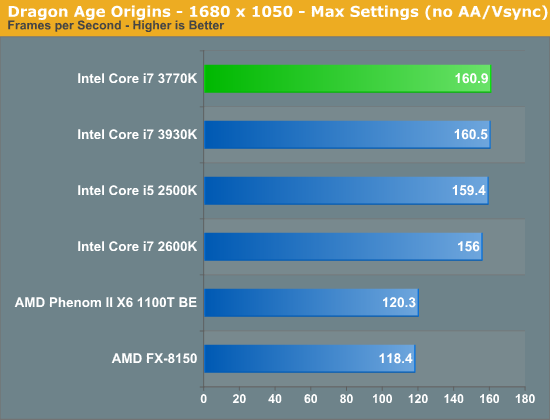
Dawn of War II
Dawn of War II is an RTS title that ships with a built in performance test. I ran at Ultra quality settings at 1680 x 1050:
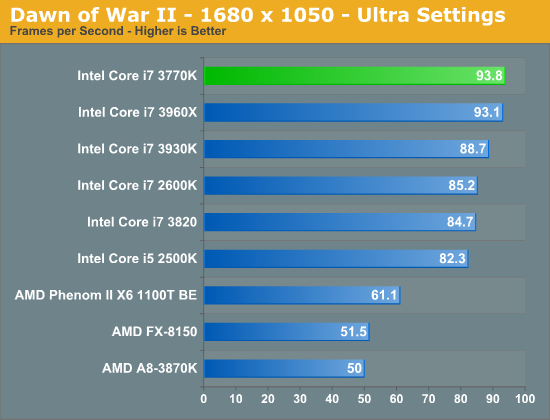
World of Warcraft
Our WoW test is run at High quality settings on a lightly populated server in an area where no other players are present to produce repeatable results. We ran at 1680 x 1050.
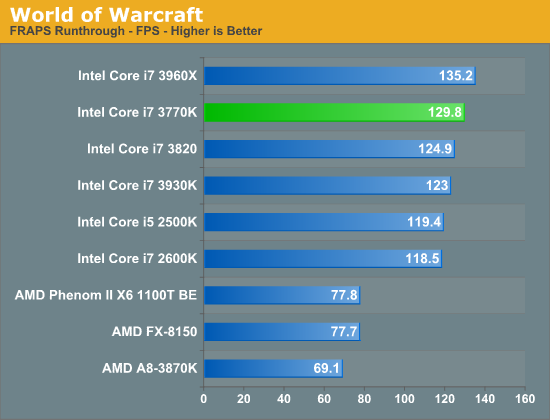
Starcraft 2
We have two Starcraft II benchmarks: a GPU and a CPU test. The GPU test is mostly a navigate-around-the-map test, as scrolling and panning around tends to be the most GPU bound in the game. Our CPU test involves a massive battle of 6 armies in the center of the map, stressing the CPU more than the GPU. At these low quality settings however, both benchmarks are influenced by CPU and GPU. We'll get to the GPU test shortly, but our CPU test results are below. The benchmark runs at 1024 x 768 at Medium Quality settings with all CPU influenced features set to Ultra.
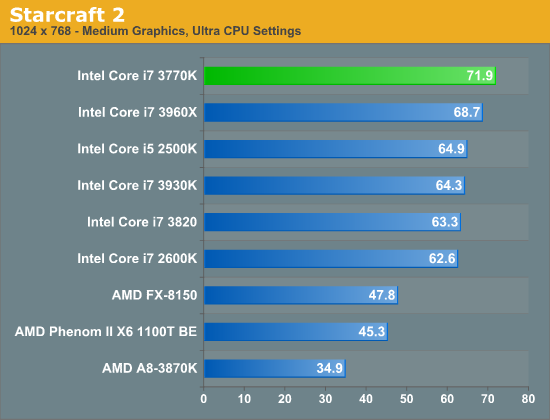
Metro 2033
We're using the Metro 2033 benchmark that ships with the game. We run the benchmark at 1024 x 768 for a more CPU bound test as well as 1920 x 1200 to show what happens in a more GPU bound scenario.

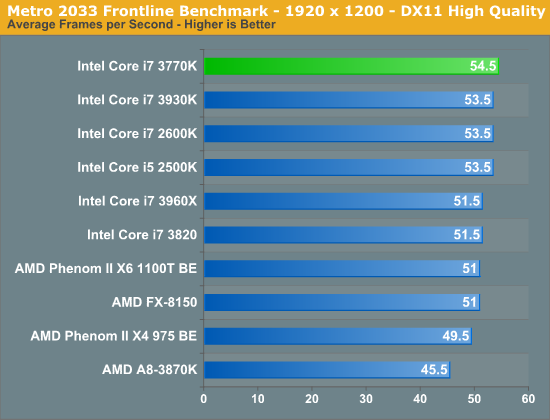
DiRT 3
We ran two DiRT 3 benchmarks to get an idea for CPU bound and GPU bound performance. First the CPU bound settings:
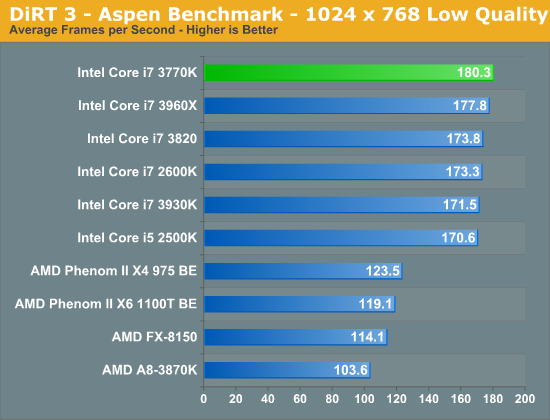
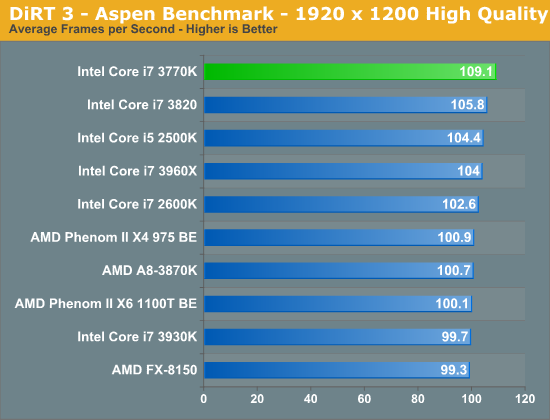
Crysis: Warhead
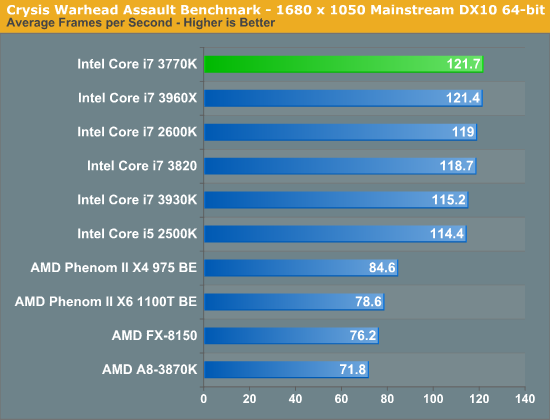
Civilization V
Civ V's lateGameView benchmark presents us with two separate scores: average frame rate for the entire test as well as a no-render score that only looks at CPU performance. We're looking at the no-render score here to isolate CPU performance alone:
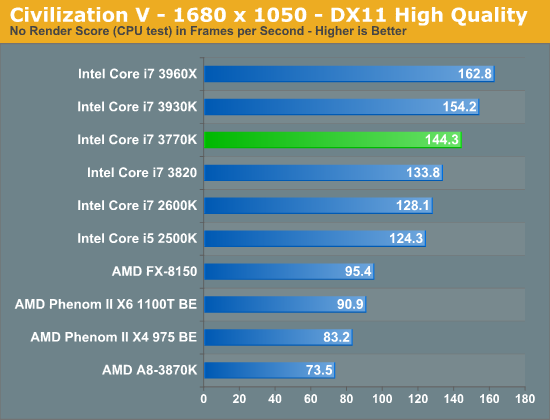










195 Comments
View All Comments
niva - Wednesday, March 7, 2012 - link
I think it's a long time away from approaching 560m performance. If you're going to do any remotely serious gaming on a laptop it's still best to get a dedicated graphics card.I'm still sticking to gaming on a tower, so these CPUs (esp the AMD llano) make sense for me in laptops. Don't ever see myself gaming on a laptop unless I completely get rid of the towers in my house... which won't happen anytime soon (if ever.)
pepperoni - Wednesday, March 7, 2012 - link
I felt the same way when I was shopping recently. I WANTED to buy a Llano-based notebook (inexpensive, better graphics vs. Intel). The problem is there's no such thing as a slim and light Llano. Every OEM sticks you with the same configuration: six pounds and 15.6" turd-768 resolution screen. It's bizarre.For the sake of competition, I hope Trinity will get some better design wins.
CeriseCogburn - Sunday, January 27, 2013 - link
If you look at the gaming charts, the resolution may go past x768, but the settings are on LOW, and don't give us a minimum frame rate, so the answer is:That's all that llano can handle is low end low rez.
So AMD forces the giant .lb weighted monster as a selling point.
poached - Wednesday, April 18, 2012 - link
so AMD?Demon-Xanth - Wednesday, March 7, 2012 - link
I agree with you there. To get those "$100 mid range GPUs" on a laptop you need to bump up the cost by around $400 to get to one that simply can have one. Most laptops currently do not have discrete GPUs.I am glad to see that integrated graphics from both Intel and AMD can now be compared with low end cards like the GT520 and GT440 without it becoming a laugh. Also that they are actually completing the tests well now. That is a rather major step. I remember some reviews of integrated graphics that resulted in a lot of either "could not complete" or "the bar is too small to fit a number on" entries.
Azethoth - Wednesday, March 7, 2012 - link
The IGP provides the QuickSync implementation. It would be insane to not include the silicon for it on the high end system. In addition moving forward you can get compute work out of the GPU so why would you ever not include it.danjw - Wednesday, March 7, 2012 - link
Quicksync the Intel video transcoding feature is based in the GPU. This is important to a lot of users.sweetspot - Wednesday, March 7, 2012 - link
Well also these make for nice office machines. So businesses upgrading there desktop workstations.When you have thousands of employees, the desktop refresh, these are decent option, since they are not gaming at work ( right lol ).
Taft12 - Sunday, March 18, 2012 - link
Hardly any large corporations buy desktops anymore. Maybe for the call centre employees, that's about it.AFUMCBill - Wednesday, March 7, 2012 - link
Because gaming isn't the only thing that uses graphics cards. For instance, more and more video editors use the graphics card for doing video decode/encode/applying effects. So having a high performance graphics engine to go along with the high performance CPU can be a really nice thing.